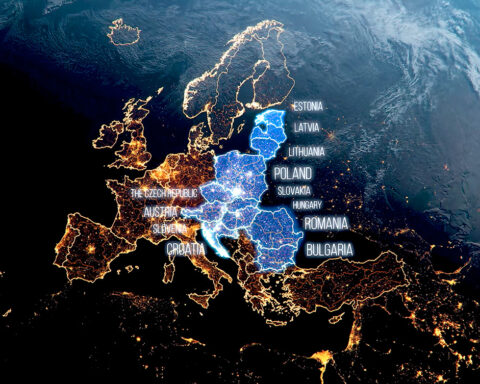This has become one of the most important indicators of the development of the modern states: investments generated by venture capital funds (VC). It is about funds that are ready to enter digital economy projects and to support the development of technology companies at their early stages. As Peter Drucker, a famous Austrian-American management consultant, underlined in 2011, “It is not capital or raw materials that develop an economy; the ultimate resource in economic development is people.” In the ongoing digital revolution, people and the ideas they generate are the most valuable asset. Venture capital investments in these ideas are the latest confirmation of the accuracy of Drucker’s observation.
The data about the amount of these investments tells us a lot about how individual countries are approaching their place in the new world economic archive. The USA and Asian countries top the list, followed by Europe. Interestingly, however, CEE countries have levels of venture capital investments similar to Western European countries. In addition, those investments are increasing rapidly. In 2022, this amounted to one billion US dollars.
Investing in the future
“Every great company starts with a great idea, but even the best ideas don’t go far without money,” wrote “Forbes” magazine, describing the role of venture capital funds. Investment in companies operating in the IT sector has become so important that it is now watched and analyzed nearly as carefully as, for example, defense spending. According to data provided by the OECD (data published without distinguishing whether investments are financed from domestic or foreign sources), most funds have been allocated to this type of investment in the United States. In 2022, it was 0.75 percent of the US GDP; in 2021, it rose to 1.1 percent of GDP. Of the countries for which the OECD has generated statistics, larger sums were allocated only in Israel – calculated as a share of GDP – reaching the level of 1.7% in 2021 (data for 2022 is unavailable).
Other countries, traditionally those seen as economic powerhouses or leaders in innovation, receive such investments on a smaller scale. For example, in Japan, they represent the equivalent of 0.06 of GDP in 2021 (data for 2022 unavailable). In South Korea – 0.2 of GDP in 2022. In France – 0.1 of GDP and in Germany – 0.09. What is particularly striking is the low level of investment in Japan and Germany – countries that are among the most developed in the world. In the first case, this is changing fast – funds are increasing their VC spending in Japan very quickly; in 2017, they were half as much as now. Meanwhile, in Germany (except in 2021), such low levels of investment have persisted for years. “Germany is still living off the glory of its past and is not investing enough in the wonders of tomorrow,” commented John Thornhill, the founder of the website about start-ups Sifted.com, in the “Financial Times.”
However, the amount of VC investment is growing rapidly in the Three Seas Initiative states. Nearly one trillion USD was spent in the 12 countries that were part of this program in 2022. Just one year earlier, it was USD 1.6 trillion, but this sum was artificially inflated by Austria, which happened to have a one-time record high in investments from VC funds in 2021 (as did Germany in the same year). If Austria were excluded from these statistics (in 2022, their spending on VC funds declined from 0.17% of GDP to 0.04%), it would be apparent that the countries of Central Europe had noted an increase in VC investments to develop the digital economy sector.
A lot of talent, even more perspiration
Which country in the region is leading the way in attracting VC investments in its digital economy? Easy question. Estonia is traditionally considered the most advanced country in IT solutions – and it also proves its opinion on venture capital. VC funds have spent the equivalent of 0.4% of Estonian GDP. It is worth noting that – measured as a share of GDP – the level of spending on VC funds in Estonia is higher than that in Germany, South Korea, or Japan.
VC spending in other Central European countries remains around the average expenditure on the continent. For example, in Lithuania, the level of VC investment reached the equivalent of 0.1% of its GDP in 2022. In Hungary – 0.05%. In Czechia – 0.04%. In such states as Bulgaria, Romania, Slovenia, and Slovakia, it was as little as 0.01%. It seems that VC funds are not prioritizing those countries in the region.
But the fact that CEE countries are not far behind more developed markets in Europe in this area symbolically shows how fast these states have been catching up after years of communism. The investments done by VC funds are evidence of the maturity of financial markets. “Venture capital is an alternative investment typically only available to institutional and accredited investors. Pension funds, big financial institutions, high-net-worth investors and wealth managers typically invest in VC funds” – “Forbes” magazine describes the specifics of such funds. In short, venture capital is typical for countries with strongly developed financial institutions and citizens with deep pockets. Central Europe is joining this group.
There is a chance that CEE countries will benefit even more strongly from the opportunities presented by the investment of VC funds for two reasons. First, they are increasingly developing their own financial institutions (e.g., pension funds), which, for the time being, have yet to progress beyond the first phase of development. Additionally, foreign funds will begin to invest more seriously in the region’s countries.
Today, the most important VC funds avoid Central Europe. But this may soon change. Sequoia Capital, one of the biggest venture capital funds globally, has published a so-called “Sequoia Atlas,” helping find the best engineering talent across Europe. Experts from this fund described 24 European cities with high concentrations of skilled IT specialists. There are seven Central European cities among these: Bucharest, Budapest, Cracow, Prague, Tallinn, Vilnius, and Warsaw. “Genius is one percent inspiration and ninety-nine percent perspiration,” – used to say famous inventor Thomas Edison. The high position of CEE cities in the “Sequoia Atlas” confirms the accuracy of Edison’s remark. And since there is no shortage of people willing to work hard in this region, it is to be expected that this position will be even higher in future lists. VC fund managers react to this kind of information like children to the news of an approaching Christmas.







